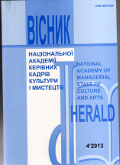The role of public library in Nikolayev city festive culture development in the early of XX century
DOI:
https://doi.org/10.32461/2226-3209.4.2013.138038Keywords:
festive culture, library, popular reading, musical morning lecture, symphonic music morningAbstract
In the article the author analyses creative, cultural and educational activity of Nikolayev public library within the study of Nikolayev city festive culture developmental features in the late 19th – early 20th centuries. The author has analyzed the latest works, studies and publications of Ukrainian historians, philosophers and culture experts such as A. Kurochkina, S. Bezklubenko, A. Limanskaya, T. Gaevskaya, O. Pan’kova, in which the object of the study was festive culture phenomenon. The author considers the works of such local histiorians as V. Shchukin, N. Shityuk, T. Berezovskaya, N. Krizhanovskaya, E. Karaul’naya, Yu. Guzenko, S. Kirienko, L. Levchenko, I.Mironova are especially noteworthy among researches of Nikolayev development in early XX century. All of the above mentioned authors just touched on the issue of Nikolayev festive culture development in their works making reference of certain concerts, evening parties, folk festivals and other cultural mass actions as a part of their scientific studies. That’s why the history of Nikolayev festive culture development is the actual and significant subject for study and research. Having studied the Nikolayev public library activity, the main aim of which was "making process of selfeducation easier for inhabitants of Nikolayev city ant its suburbs", having analyzed the public library’s reports and records for 1909- 1915 years, posters of events organized by library administration, the author emphasizes such cultural mass events as public lectures, people’s readings, musical and symphonic matinees held by public library. In the article the author focuses on Nikolayev public and its organizing and holding public lectures? The main aim of which was to give the scientific knowledge to illiterate and hag-educated inhabitants of Nikolayev in accessible language. So in 1900 the administration was allowed to organize and hold such lectures. On January 9 1909 the was the first public lecture. The Theme of which was anatomy and physiology. In general lectures were taken on 10 subjects: hygiene, biology, mathematics, accountancy, zoology and others. The main topics of public lectures were "Problems of philosophy and history", "Searching Philosopher's Stone", "About aeronautics", "About the freedom of conscience", "Marriage, family and school" and other. Factory workers and employees listened to these lectures with pleasure. To make the lectures more interesting the speakers were invited from Moscow. Next step in library activity and in history of Nikolayev festive culture development was holding of people’s readings, the author describes them in his works. Such events had a form of literature evenings during which lecturers read foreign and national literature in public, and them made a short analysis of these works. Folk readings were often accompanied by dissolving views. People’s readings were very popular with Nikolayev, and halls were always over crowded. The most favorite writers of Nikolayev people were A. P. Chekhov, A. I. Koltsov, I. S. Turgenev, L M. Tolstoy, and others. Nikolayev audience heard such literary works as A. Chekhov "In a gulley’’, "Surgery", "Chameleon", "Dog-fish", "Officer Prishibeev", "Melancholy"; N. Nekrasov "Who lives good in Russ?"; O. Tolstoy "Bogatyr"; I. S. Turgenev "Singers", "Dream"; O. K. Tolstoy "Wise gudgeon", "Crucian carp-idealist", "Brave hare" and others.Downloads
Published
Issue
Section
License
Authors who publish with this journal agree to the following terms:
1. Authors retain copyright and grant the journal right of first publication with the work simultaneously licensed under a Creative Commons Attribution License International CC-BY that allows others to share the work with an acknowledgement of the work's authorship and initial publication in this journal.
2. Authors are able to enter into separate, additional contractual arrangements for the non-exclusive distribution of the journal's published version of the work (e.g., post it to an institutional repository or publish it in a book), with an acknowledgement of its initial publication in this journal.
3. Authors are permitted and encouraged to post their work online (e.g., in institutional repositories or on their website) prior to and during the submission process, as it can lead to productive exchanges, as well as earlier and greater citation of published work (See The Effect of Open Access).


